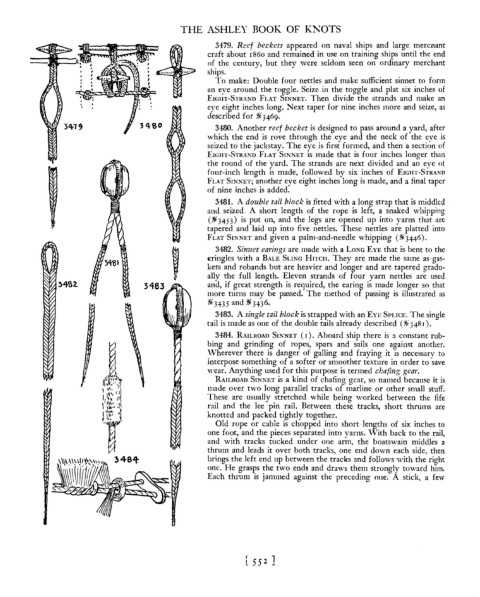Page 561 - The Ashley Book of Knots
P. 561
THE ASHLEY BOOK OF KNOTS
3479. Reef beckets appeared on naval ships and large mercnant
craft about 1860 and remained in use on training ships until the end
,
,
, of the century, but they were seldom seen on ordinary merchant
• , •
• , • ships.
f
I To make: Double four nettles and make sufficient sinnet to form
an eye around the toggle. Seize in the toggle and plat six inches of
EIGHT-STRAND FLAT SINNET. Then divide the strands and make an
•
• • •
•
• • • eye eight inches long. Next taper for nine inches more and seize, as
described for 11: 3469.
3480. Another reef becket is designed to pass around a yard, after
which the end is rove through the eye and the neck of the eye is
seized to the jackstay. The eye is first formed, and then a section of
EIGHT-STRAND FLAT SINNET is made that is four inches longer than
the round of the yard. The strands are next divided and an eye 01
four-inch length is made, followed by six inches of EIGHT-STRAND
FLAT SINNET; another eye eight inches long is made, and a final taper
of nine inches is added.
3481. A double tail block is fitted with a long strap that is middlcd
and seized. A short length of the rope is left, a snaked whipping
(11: 3453) is put on, and the legs are opened up into yarns that are
tapered and laid up into five nettles. These nettles are platted into
FLAT SINNET and given a palm-and-needle whipping (11: 3446).
3482. Sinnet earings are made with a LONG EYE that is bent to the
t:ringles with a BALE SLING HITCH. They are made the same as gas-
kets and robands but are heavier and longer and are tapered gradu-
ally the full length. Eleven strands of four yarn nettles are used
~4e2. 3463 and, if great strength is required, the earing is made longer so that
more turns may be passed. The method of passing is illustrated as
11: 3435 and 11: 3436.
3483. A single tail block is strapped with an En: SPLICE. The single
tail is made as one of the double tails already described (~348 I).
3484. RAILROAD SINNET (I). Aboard ship there is a constant rub-
bing and grinding of ropes, spars and sails one against another.
Wherever there is danger of galling and fraying it is necessary to
interpose something of a softer or smoother texture in order to save
wear. Anything used for this purpose is termed cbafing gear.
RAILROAD SINNET is a kind of chafing gear, so named because it is
made over two long parallel tracks of marline or other small stuff.
These arc usually stretched while being worked between the fife
rail and the lee pin rail. Between these tracks, short thrums are
knotted and packed tightly together.
Old rope or cable is chopped into short lengths of six inches to
one foot, and the pieces separated into yarns. With back to the rail,
and with tracks tucked under one arm, the boatswain middles a
thrum and leads it over both tracks, one end down each side, then
brings the left end up between the tracks and follows with the right
\\\ \ \ 1..\.1
, . ~ ,
•
one. He grasps the two ends and draws them strongly toward him.
\ II \ Each thrum is jammed against the preceding one. A stick, a few
\
[ 55 2 ]

